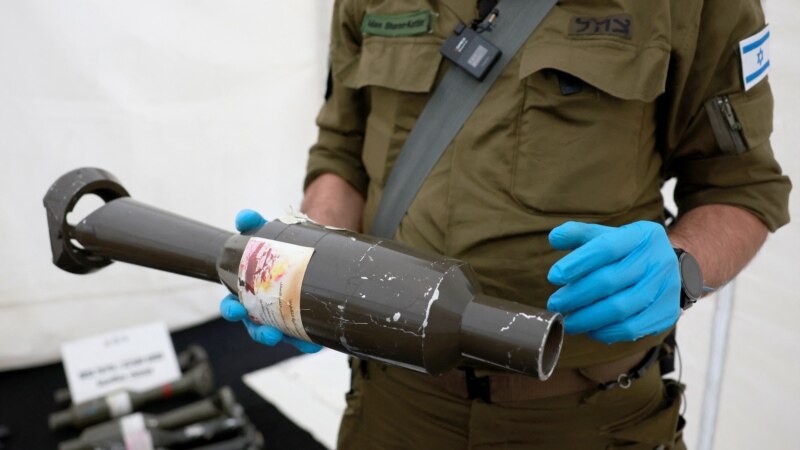An Accusation in a Mirror: Iran Sponsors Hamas and Hezbollah but Claims It’s Ukraine
Russia and its allies continue to use Hamas’ October 7 assault on Israel to undermine Western support for Ukraine.
That includes repeated, evidence-free claims by Moscow that Western arms intended for Ukraine had been siphoned out of the country via the “black market.”
Recently, a top official from Russia ally Iran voiced unsubstantiated allegations that the Lebanon-based Shiite militant group Hezbollah and the Gaza-based militant group Hamas have easy access to illicit arms via Ukraine. That includes the unsupported claim that Iran has halted its provision of arms to those groups.
“You see, in the past — I wish to be absolutely frank with you — we used to provide all kinds of support to Hezbollah, Hamas and Islamic Jihad while taking into account [both] international law and the conditions of confronting the occupier [Israel],” Russia’s TASS news agency cites Iranian Foreign Minister Hossein Amir-Abdollahian as saying at the 21st Doha Forum in Qatar on December 11.
Abdollahian then went on amplifying the Kremlin’s disinformation:
“If you ask me where they can obtain weapons, then one of the black markets where they [Hamas and Hezbollah] can get them is Ukraine. Very easily, without much effort, they can get whatever [they need] in Ukraine.”
The claim is baseless and likely false.
There is no evidence Hamas or Hezbollah can get weapons in Ukraine.
By contrast, Iran does have a well-established track record of providing financial and military support to those groups and has given military and political support to help Russia prosecute its war in Ukraine.
From the outset of hostilities in October, the Institute for the Study of War, a Washington, D.C.-based think tank, said the Kremlin was exploiting “the Hamas attacks in Israel to advance several information operations intended to reduce U.S. and Western support and attention to Ukraine.”
To achieve this end, Russian state media and officials have claimed that “nonexistent controls” on U.S. arms shipments to Ukraine “would result in the weapons ending up in the criminal underworld.”
On November 9, Dmitry Medvedev, the former Russian president and prime minister who is now deputy chairman of Russia’s Security Council, claimed without evidence that “tanks,” “jets,” “missiles” and other arms provided by the West to help Ukraine defend itself against Russia would end up on the “black market.”
There are multilateral measures by the United States, Europe, and Ukraine to ensure the transparency of the arms transfer and their further use.
The U.S. government has outlined the “concrete steps” it is taking “to counter threats posed by potential diversion of weapons in Eastern Europe.”
The U.S. government is legally required to ensure defense articles supplied to U.S. partners and allies are used as intended.
Ukraine, which relies on Western arms to defend itself against Russia’s invading force, is also incentivized to combat illicit smuggling that could endanger already flagging Western support.
Former anti-corruption activist and current Ukrainian lawmaker Oleksandra Ustinova told The New York Times in May that Ukraine has “literally had people die” to ensure that Western-provided arms were not stolen or lost.
In an interview with Reuters in May, European Commissioner for Home Affairs Ylva Johansson said, “We have not seen any industrial smuggling of firearms out of Ukraine.”
Social media users have also disseminated fakes to spread the false claim that Ukraine has armed Hamas.
That includes a fake video attributed to the BBC, claiming Ukraine was providing arms to Hamas, and a fake Washington Post article claiming weapons supplies from Ukraine to Hamas had tripled over a month’s time.
In 2022, prior to the Israel-Hamas war, social media users also spread the false claim that Ukraine had sold U.S.-supplied Javelin antitank missile systems to Hezbollah and Hamas.
In June, Polygraph.info documented a false claim spread by several media outlets that a Javelin intended for Ukraine had ended up in the hands of a Mexican drug cartel.
A top Ukraine intelligence agency has accused Russia of fueling this disinformation campaign to get the West to suspend arms shipments to Ukraine.
Ukraine has also accused Russia of giving Hamas arms it seized in Ukraine, although there is no evidence to support this allegation.
But Iran’s support to militants in the region is well-documented.
For decades, Iran has supported Hezbollah, a Shiite Muslim political party and militant group based in Lebanon, whose military wing is more powerful than the Lebanese army.
Hezbollah has been instrumental in the decades-long Iran–Israel proxy conflict and the Israel-Lebanon conflict.
In 2020, the U.S. State Department estimated Iran had provided Hezbollah $700 million a year in funding.
Experts estimate Hezbollah’s 100,000-plus arsenal of rockets has multiplied by up to 10 times since the militant group fought a war with Israel in 2006.
Iran also provides Hamas with weapons, funding and training. Ties between Hamas and Iran deepened after Hamas won the 2006 Palestinian legislative election and forcefully seized control of the Gaza Strip in 2007.
There is no indication Iran has ever stopped this support. In November, the U.S. Treasury sanctioned 21 Iran-linked individuals and entities for engaging “in illicit finance schemes to generate funds to fan conflict and spread terror throughout the region.” Those illicit activities include supporting “multiple regional proxy groups,” including Hamas and Hezbollah.
Iran’s role in the October 7 attack remains unclear.
Iran has also provided Russia with military unmanned aerial vehicles and other support to prosecute its war in Ukraine.
The U.S. has sanctioned Iranian individuals for providing those drones, noting they are used to attack civilian targets. The U.S. says Iran has violated the United Nations Security Council Resolution 2231, “which prohibits Iran’s provision of military UAVs to Russia without advance, case-by-case approval of the U.N. Security Council.”
This article has been archived for your research. The original version from Polygraph.info can be found here.




